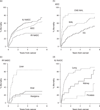Mortality after cancer diagnosis in HIV-infected individuals treated with antiretroviral therapy
- PMID: 21160411
- PMCID: PMC4379707
- DOI: 10.1097/QAD.0b013e3283437f77
Mortality after cancer diagnosis in HIV-infected individuals treated with antiretroviral therapy
Abstract
Objectives: To evaluate survival and predictors of mortality after cancer diagnosis among HIV-infected persons receiving combination antiretroviral therapy (cART).
Design: Multisite cohort study.
Methods: We examined all-cause mortality among HIV-infected patients treated with cART in routine care at eight US sites and diagnosed with cancer between 1996 and 2009, and predictors of mortality using Cox proportional hazards regression models. Non-AIDS-defining cancers (NADCs) were classified as related and unrelated to viral coinfections.
Results: Out of 20 677 persons in the Centers for AIDS Research Network of Integrated Clinical Systems cohort, 650 cART-treated individuals developed invasive cancer. Of these, 305 died during 1480 person-years of follow-up; crude mortality rate was 20.6 per 100 person-years [95% confidence interval (CI) 18.4, 23.1] and overall 2-year survival was 58% (95% CI 54, 62). Highest mortality was seen in primary central nervous system non-Hodgkin's lymphoma, liver, and lung cancer with rates of 90.6, 84.3, and 68.1 per 100 person-years, respectively. Adjusted hazard of death was higher among those who were older and had stage IV cancer. Adjusted hazard of death was lower among those with higher CD4 cell counts at cancer diagnosis, who achieved HIV-RNA suppression (≤400 copies/ml) on cART, received any cancer treatment, and had AIDS-defining cancer or infection-related NADCs compared to infection-unrelated NADCs.
Conclusion: Independent predictors of mortality after cancer diagnosis among HIV-infected persons include poor immune status, failure to suppress HIV-RNA on cART, cancer stage, and lack of cancer treatment. Modification of these factors with improved strategies for the prevention and treatment of HIV and HIV-associated malignancies are needed.
Figures

References
-
- Palella FJ, Jr, Delaney KM, Moorman AC, Loveless MO, Fuhrer J, Satten GA, et al. Declining morbidity and mortality among patients with advanced human immunodeficiency virus infection. HIV Outpatient Study Investigators. N Engl J Med. 1998;338:853–860. - PubMed
-
- Mocroft A, Ledergerber B, Katlama C, Kirk O, Reiss P, d’Arminio Monforte A, et al. Decline in the AIDS and death rates in the EuroSIDA study: an observational study. Lancet. 2003;362:22–29. - PubMed
-
- Engels EA, Biggar RJ, Hall HI, Cross H, Crutchfield A, Finch JL, et al. Cancer risk in people infected with human immunodeficiency virus in the United States. Int J Cancer. 2008;123:187–194. - PubMed
-
- Burgi A, Brodine S, Wegner S, Milazzo M, Wallace MR, Spooner K, et al. Incidence and risk factors for the occurrence of non-AIDS-defining cancers among human immunodeficiency virus-infected individuals. Cancer. 2005;104:1505–1511. - PubMed
-
- Frisch M, Biggar RJ, Engels EA, Goedert JJ. Association of cancer with AIDS-related immunosuppression in adults. JAMA. 2001;285:1736–1745. - PubMed
Publication types
MeSH terms
Substances
Grants and funding
LinkOut - more resources
Full Text Sources
Medical
Research Materials

